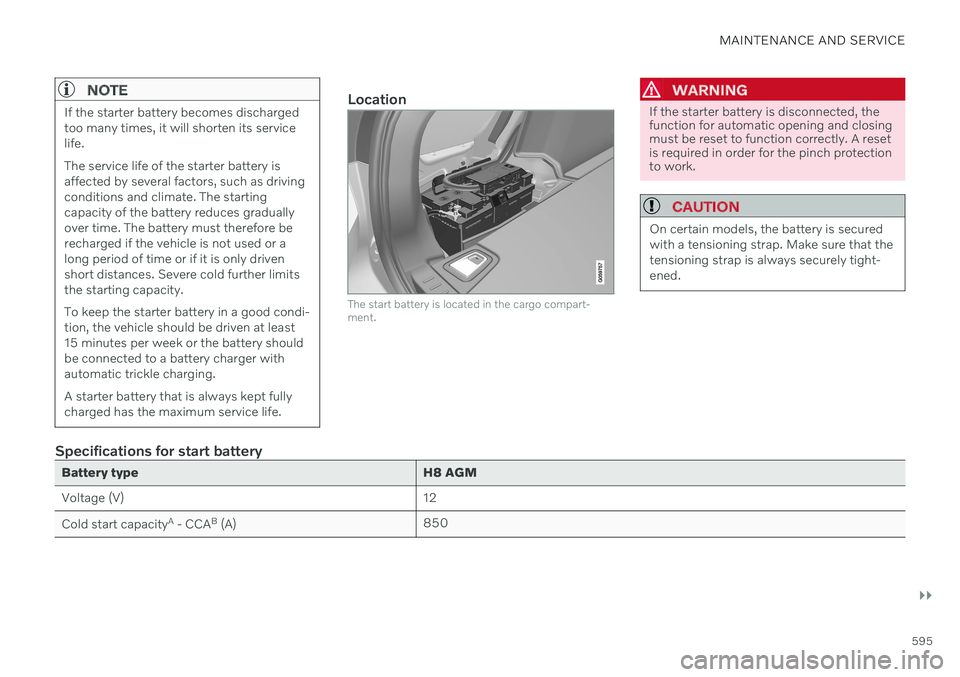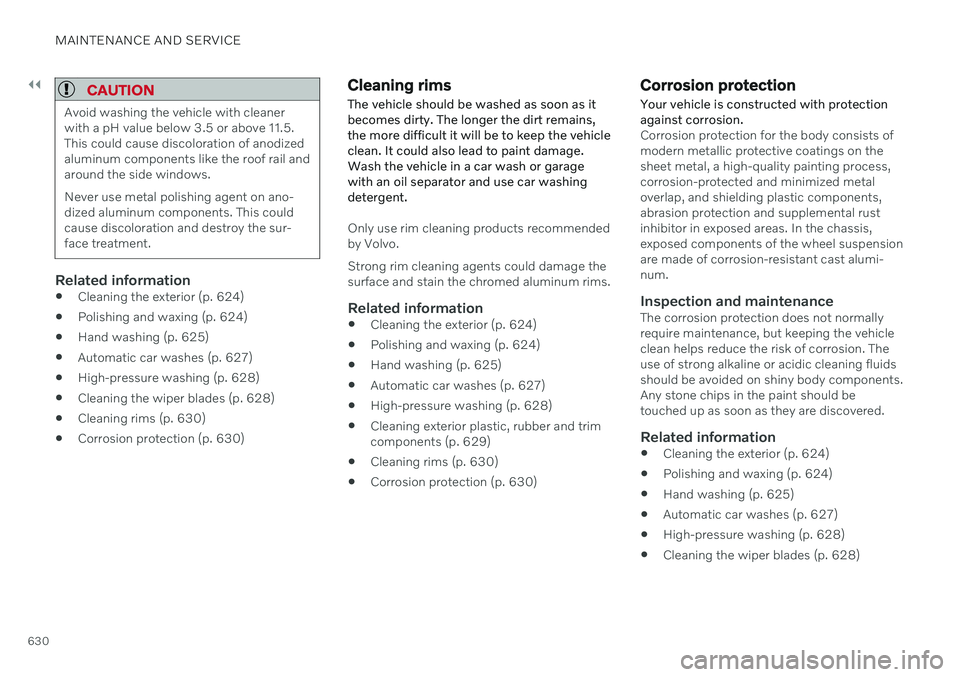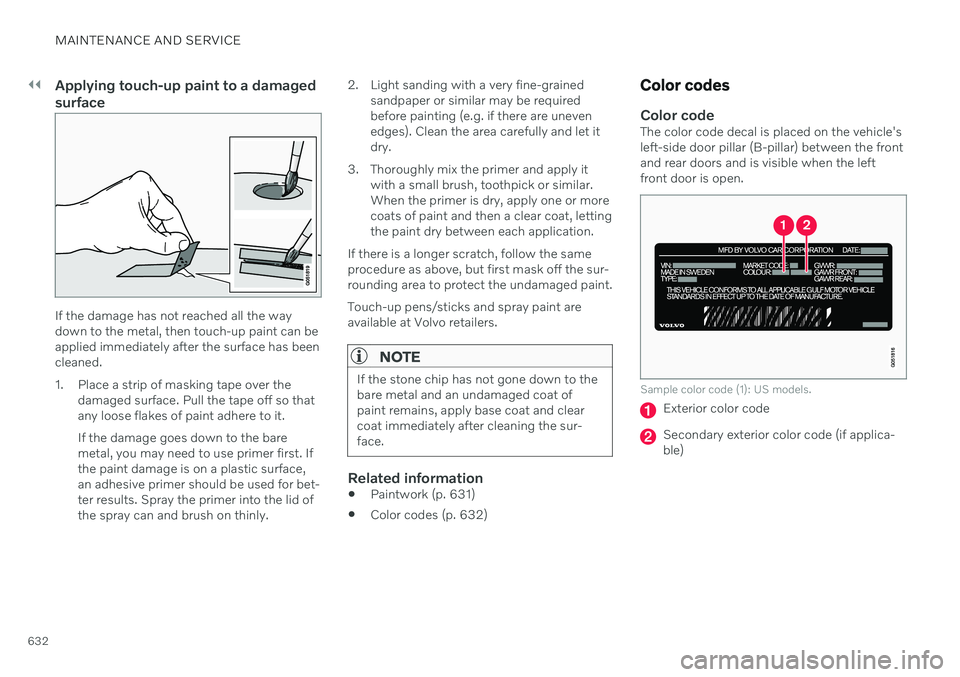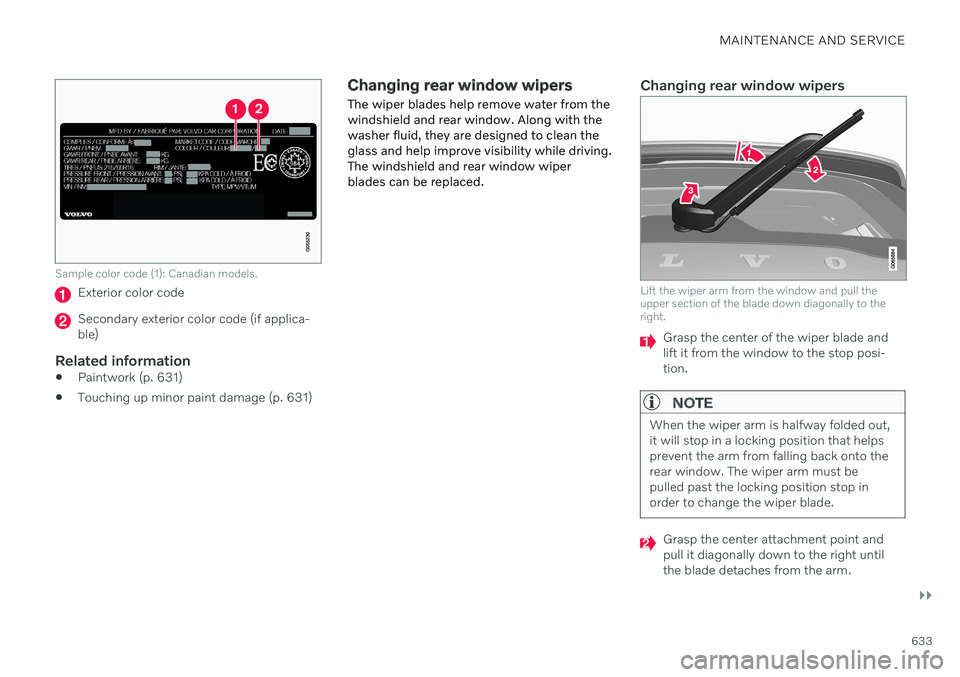ECO mode VOLVO V60 TWIN ENGINE 2020 Owners Manual
[x] Cancel search | Manufacturer: VOLVO, Model Year: 2020, Model line: V60 TWIN ENGINE, Model: VOLVO V60 TWIN ENGINE 2020Pages: 673, PDF Size: 14.2 MB
Page 591 of 673

MAINTENANCE AND SERVICE
}}
589
a warning symbol is displayed in the instru- ment panel when oil pressure is low
. On
engine variants with an oil level sensor, the
warning symbol in the instrument panel
and display messages are used to alert the driver. Some engine variants have both sys-tems. Contact a Volvo retailer for more infor-mation. Change the engine oil and oil filter according to the schedule specified in the Warranty andMaintenance Records Information booklet.Oils of a higher grade than that specified maybe used. If the vehicle is driven in adverse con-ditions, Volvo recommends using an oil with ahigher grade than that specified.
Related information
Checking and filling engine oil (p. 589)
Engine oil specifications (p. 648)
Checking and filling engine oil
The engine oil level is monitored by an elec- tronic oil level sensor.
Filler pipe 1314
It may be necessary to top up engine oil between regularly scheduled services. No action is necessary with regard to engine oil level until a message appears in the instru-ment panel.
WARNING
If this symbol is shown together with the message Engine oil
level Service required, visit a
workshop – an authorized Volvo
workshop is recommended. The oil level may be too high.
CAUTION
If this symbol is shown together with a message about low oil level, for example
Engine oil
level low Refill 1 liter, fill only
with the indicated volume, e.g. 1 liter (1 quart).
WARNING
Do not spill oil on the hot exhaust pipes as this could cause a fire.
Viewing oil level in the center displayThe oil level can be viewed using the elec- tronic oil level gauge in the center display oncethe vehicle has been started. The oil levelshould be checked regularly.
13 Engines with an electronic oil level sensor do not have a dipstick.
14 The layout of the engine compartment may vary depending on model and engine variant.
Page 597 of 673

MAINTENANCE AND SERVICE
}}
595
NOTE
If the starter battery becomes discharged too many times, it will shorten its servicelife. The service life of the starter battery is affected by several factors, such as drivingconditions and climate. The startingcapacity of the battery reduces graduallyover time. The battery must therefore berecharged if the vehicle is not used or along period of time or if it is only drivenshort distances. Severe cold further limitsthe starting capacity. To keep the starter battery in a good condi- tion, the vehicle should be driven at least15 minutes per week or the battery shouldbe connected to a battery charger withautomatic trickle charging. A starter battery that is always kept fully charged has the maximum service life.Location
The start battery is located in the cargo compart- ment.
WARNING
If the starter battery is disconnected, the function for automatic opening and closingmust be reset to function correctly. A resetis required in order for the pinch protectionto work.
CAUTION
On certain models, the battery is secured with a tensioning strap. Make sure that thetensioning strap is always securely tight-ened.
Specifications for start battery
Battery typeH8 AGM
Voltage (V) 12
Cold start capacity A
- CCA B
(A) 850
Page 601 of 673

MAINTENANCE AND SERVICE
}}
599
Fuses and fuseboxes All electrical functions and components are protected by a number of fuses in order toprotect the vehicle's electrical system fromdamage by short circuiting or overloading.
WARNING
Never use a foreign object or a fuse with a higher amperage than that specified toreplace a fuse. This could cause significantdamage to the electrical system and possi-bly lead to a fire.
WARNING
Orange wiring may only be handled by qualified personnel.
WARNING
A number of electrical components in Twin Engine Plug-in Hybrid vehicles use high-voltage current and can be extremely dan-gerous if handled incorrectly. Do not touch anything that is not clearly described in the vehicle's Owner's Manual.
If any electrical component or function is not responding, the component may have blown a fuse due to temporary overload. If the same fuse blows repeatedly, there may be a prob-lem with the component. Volvo recommendscontacting an authorized Volvo workshop tohave the component checked.
Location of fuseboxes
The illustration is generic - appearance may vary according to vehicle model.
Engine compartment
Under the glove compartment
Trunk/cargo compartment
Related information
Replacing fuses (p. 599)
Fuses in the cargo compartment (p. 614)
Fuses in the engine compartment(p. 601)
Fuses under the glove compartment(p. 608)
Replacing fuses
All electrical functions and components are protected by a number of fuses in order toprotect the vehicle's electrical system fromdamage by short circuiting or overloading.
1. Refer to the fuse diagram to locate the fuse.
2. Pull out the fuse and examine it from the side to determine if the curved metal wire in the fuse is intact.
3. If the wire is broken, replace the fuse with a new fuse of the same color and amper-age.
WARNING
Never use a foreign object or a fuse with a higher amperage than that specified toreplace a fuse. This could cause significantdamage to the electrical system and possi-bly lead to a fire.
WARNING
Contact an authorized Volvo workshop for assistance replacing fuses not listed in theOwner's Manual. If fuse replacement isperformed incorrectly, significant damagecan be caused to the electrical system.
Page 629 of 673

MAINTENANCE AND SERVICE
}}
* Option/accessory.627
Automatic car washes
The vehicle should be washed as soon as it becomes dirty. The longer the dirt remains,the more difficult it will be to keep the vehicleclean. It could also lead to paint damage.
Washing your vehicle in an automatic car wash is a fast and easy way to keep your vehi-cle clean, but it does not reach all areas of thevehicle. Volvo recommends washing yourvehicle by hand or supplementing automaticcar washes with a hand wash.
NOTE
Volvo recommends not washing the vehi- cle in an automatic car wash during thefirst few months; the paintwork on newvehicles takes some time to fully harden.
CAUTION
Before driving the vehicle into a car wash, deactivate the Automatic Braking whenStationary and Automatic Parking BrakeApplication functions. If the functions arenot deactivated, the brake system willseize when the vehicle is stationary and thevehicle will not be able to roll.
CAUTION
For automatic car washes in which the vehicle is pulled forward on rolling wheels:
1. Before washing the vehicle, make sure that the automatic rain sensor is deac- tivated. If it is not deactivated andinadvertently starts, the wiper armscould be damaged.
2. To help prevent damage from the auto- matic car wash machinery, make surethat the door mirrors are folded in,antennas retracted or removed, andany auxiliary lights secured.
3. Drive into the automatic car wash.
4. Turn off the "Automatic Braking when Stationary" function using the
but-
ton in the tunnel console.
5. Turn off the "Automatic Parking Brake Application" function in the center dis- play's Top view.
6. Turn off the engine by turning the start knob in the tunnel console clockwise.Hold the knob in position for at least2 seconds.
The vehicle is now ready for the automaticcar wash.
CAUTION
The system will automatically change to P
mode if the above steps are not followed. In P mode, the wheels are locked, which
they should not be when the vehicle isbeing washed in a car wash.
NOTE
Keep in mind that if the vehicle is equipped with the keyless locking and unlocking function *, the doors and tailgate/trunk lid
may open when washing the vehicle if the remote key is within range.
Related information
Cleaning the exterior (p. 624)
Polishing and waxing (p. 624)
Hand washing (p. 625)
High-pressure washing (p. 628)
Cleaning the wiper blades (p. 628)
Cleaning exterior plastic, rubber and trim components (p. 629)
Cleaning rims (p. 630)
Corrosion protection (p. 630)
Auto-hold brakes (p. 412)
Page 632 of 673

||
MAINTENANCE AND SERVICE
630
CAUTION
Avoid washing the vehicle with cleaner with a pH value below 3.5 or above 11.5.This could cause discoloration of anodizedaluminum components like the roof rail andaround the side windows. Never use metal polishing agent on ano- dized aluminum components. This couldcause discoloration and destroy the sur-face treatment.
Related information
Cleaning the exterior (p. 624)
Polishing and waxing (p. 624)
Hand washing (p. 625)
Automatic car washes (p. 627)
High-pressure washing (p. 628)
Cleaning the wiper blades (p. 628)
Cleaning rims (p. 630)
Corrosion protection (p. 630)
Cleaning rims
The vehicle should be washed as soon as it becomes dirty. The longer the dirt remains,the more difficult it will be to keep the vehicleclean. It could also lead to paint damage.Wash the vehicle in a car wash or garagewith an oil separator and use car washingdetergent.
Only use rim cleaning products recommended by Volvo. Strong rim cleaning agents could damage the surface and stain the chromed aluminum rims.
Related information
Cleaning the exterior (p. 624)
Polishing and waxing (p. 624)
Hand washing (p. 625)
Automatic car washes (p. 627)
High-pressure washing (p. 628)
Cleaning exterior plastic, rubber and trimcomponents (p. 629)
Cleaning rims (p. 630)
Corrosion protection (p. 630)
Corrosion protection Your vehicle is constructed with protection against corrosion.
Corrosion protection for the body consists of modern metallic protective coatings on thesheet metal, a high-quality painting process,corrosion-protected and minimized metaloverlap, and shielding plastic components,abrasion protection and supplemental rustinhibitor in exposed areas. In the chassis,exposed components of the wheel suspensionare made of corrosion-resistant cast alumi-num.
Inspection and maintenanceThe corrosion protection does not normallyrequire maintenance, but keeping the vehicleclean helps reduce the risk of corrosion. Theuse of strong alkaline or acidic cleaning fluidsshould be avoided on shiny body components.Any stone chips in the paint should betouched up as soon as they are discovered.
Related information
Cleaning the exterior (p. 624)
Polishing and waxing (p. 624)
Hand washing (p. 625)
Automatic car washes (p. 627)
High-pressure washing (p. 628)
Cleaning the wiper blades (p. 628)
Page 634 of 673

||
MAINTENANCE AND SERVICE
632
Applying touch-up paint to a damaged surface
If the damage has not reached all the way down to the metal, then touch-up paint can beapplied immediately after the surface has beencleaned.
1. Place a strip of masking tape over thedamaged surface. Pull the tape off so that any loose flakes of paint adhere to it. If the damage goes down to the bare metal, you may need to use primer first. Ifthe paint damage is on a plastic surface,an adhesive primer should be used for bet-ter results. Spray the primer into the lid ofthe spray can and brush on thinly. 2. Light sanding with a very fine-grained
sandpaper or similar may be requiredbefore painting (e.g. if there are unevenedges). Clean the area carefully and let itdry.
3. Thoroughly mix the primer and apply it with a small brush, toothpick or similar.When the primer is dry, apply one or morecoats of paint and then a clear coat, lettingthe paint dry between each application.
If there is a longer scratch, follow the sameprocedure as above, but first mask off the sur-rounding area to protect the undamaged paint. Touch-up pens/sticks and spray paint are available at Volvo retailers.
NOTE
If the stone chip has not gone down to the bare metal and an undamaged coat ofpaint remains, apply base coat and clearcoat immediately after cleaning the sur-face.
Related information
Paintwork (p. 631)
Color codes (p. 632)
Color codes
Color codeThe color code decal is placed on the vehicle's left-side door pillar (B-pillar) between the frontand rear doors and is visible when the leftfront door is open.
Sample color code (1): US models.
Exterior color code
Secondary exterior color code (if applica- ble)
Page 635 of 673

MAINTENANCE AND SERVICE
}}
633
Sample color code (1): Canadian models.
Exterior color code
Secondary exterior color code (if applica- ble)
Related information
Paintwork (p. 631)
Touching up minor paint damage (p. 631)
Changing rear window wipers The wiper blades help remove water from the windshield and rear window. Along with thewasher fluid, they are designed to clean theglass and help improve visibility while driving.The windshield and rear window wiperblades can be replaced.Changing rear window wipers
Lift the wiper arm from the window and pull the upper section of the blade down diagonally to theright.
Grasp the center of the wiper blade and lift it from the window to the stop posi-tion.
NOTE
When the wiper arm is halfway folded out, it will stop in a locking position that helpsprevent the arm from falling back onto therear window. The wiper arm must bepulled past the locking position stop inorder to change the wiper blade.
Grasp the center attachment point and pull it diagonally down to the right untilthe blade detaches from the arm.
Page 644 of 673

||
SPECIFICATIONS
642
Federal Motor Vehicle Safety Standards
(FMVSS) specifications (USA) and Ministry of Transport (CMVSS) standards (Canada).Your Volvo is designed to meet all applicablesafety standards, as evidenced by the certifi-cation label on the driver's side B-pillar (thestructural member at the side of the vehicle, atthe rear of the driver's door opening). Thislabel also includes codes for paint color, etc.For further information regarding these regula-tions, please consult your Volvo retailer. U.S.models have the upper decal; Canadian mod-els have the lower one. Engine oil. This label contains the recom-
mended engine oil specifications.
Decal A/C. Refrigerant R134a.
NOTE
The decals shown in the Owner's Manual do not claim to be exact reproductions ofthose found in the vehicle. The purpose isto show approximately how they look andabout where they are located on the vehi-cle. The information that applies for yourvehicle in particular is found on the decalon the vehicle.
Related information
Air conditioning specifications (p. 650)
Page 658 of 673

INDEX
656Color codes 632
Compass 454, 455
calibration 455
Condensation in headlights 625, 627, 628, 629
Connecting vehicle to Internet No connection or poor connection 509
via a mobile device (WiFi) 505
via cellular phone (Bluetooth) 505
via vehicle's modem 506
Connect phone 496
Contact information 26
Convertible seats 69
coolant 649 filling 590
Cooling system overheating 441
Cornering assistance 302 activating/deactivating 303
limitations 303
Cornering illumination 158
Corner Traction Control 269
Corrosion protection 630 Covering cargo compartment 569
Crash, see Collision 42
Crash event data 33
Cross Traffic Alert 333 activating/deactivating 334
limitations 334
messages 336
Cruise control 275 activating 276
manage speed 298
standby mode 277
turn off 277
Curb weight 645
Customer Privacy Policy 35
CZIP (Clean Zone Interior Package) 204
D
Data recording 33 transferring between vehicle and
workshop 579
Data sharing 510, 511
Daytime running lights 153Decals location 640
Defrosting 216 Detecting obstacles City Safety 318
Dimensions 643
Dipstick, electronic 589
Direction of rotation 528Display
driver information 80
Display lighting 162
Distance Alert 273 activating/deactivating 274
limitations 274
Set time interval 299
DivX ®
484
Door mirrors 169 compass 454, 455
dimming 170
outer 169
power folding 170
resetting 170
store position 186, 187
Download Center 579 use 580
Driveline transmission 414
Drive mode 421 changing 425
driver support 301
Driver Alert Control 342 activating/deactivating 343
Page 659 of 673

INDEX
657
limitations 344
rest stop guidance 343
Driver performance 88 settings 89
Driver profile 133 edit 134, 135, 137
select 134
Driver support system 268 Drive mode 301
Drive systems 420 Driving cooling system 441
with a trailer 444
Driving economy 429
Driving through standing water 434driving with a trailer towball load 646
towing capacity 646
E
Economical driving 429
Electrical outlet 560
use 562
Electrical system 593
Electric drive motor specifications 647
electric motor 420 Range 431
Electric parking brake 408
Electronic immobilizer 247
emergency brake lights 159
Emission inspection readiness 576Energy distribution using map data 426
Engine automatic start and stop of combus-
tion engine 421
overheating 441
start 400
turn off 402
Engine braking 405, 415 Engine compartment coolant 590
engine oil 588
overview 587
Engine drag control 269
Engine oil 588 filling 589
filter 588
grade and volume 648
Engine shutdown 402Engine specifications 647 Engine temperature high 441
Environment 28Ethanol content max. 10% by volume 437
Exterior dimensions 643
Extra heater (Auxiliary heater) 229
F
Federal Clean Air Act 576
Ferry transport 427
Flooded road 434
Fluids, volumes 636, 650
Fluids and oils 649, 650 Fog lights front 157
rear 158
Four-C 427 Front seat blower 218
climate 211
heating 212, 213
temperature 219
ventilation 213